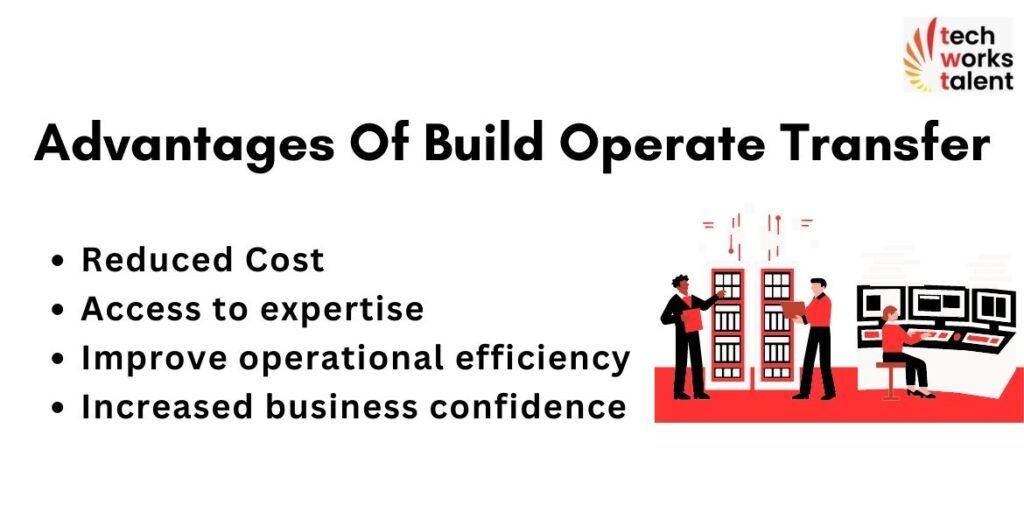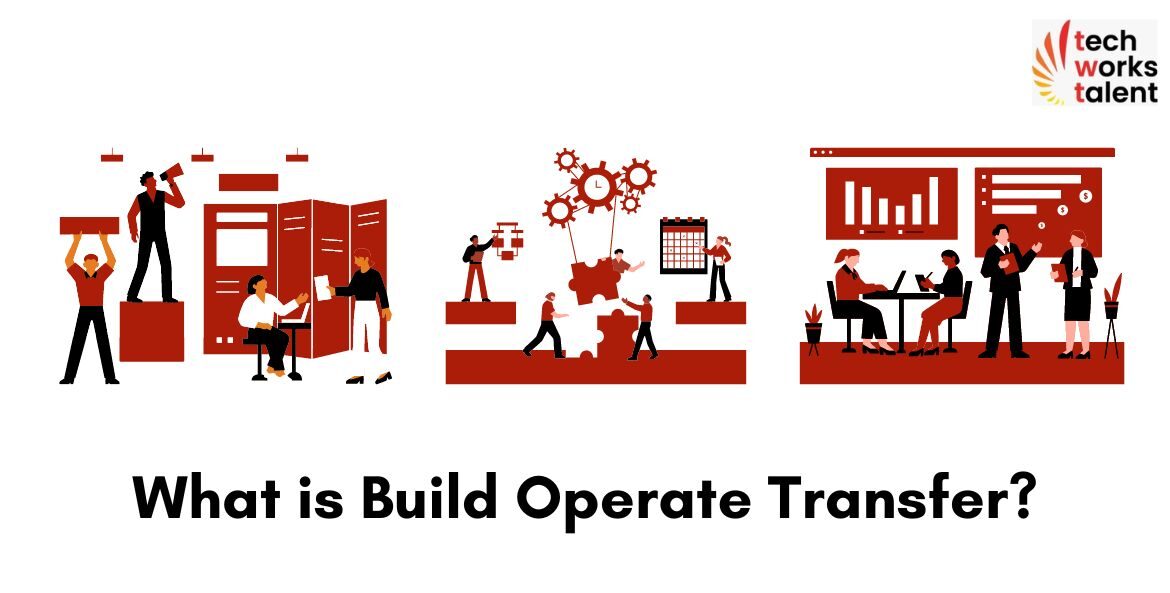According to a recent report, the global IT outsourcing market is expected to reach $383 billion by 2025, reflecting the growing demand for IT services. This highlights the importance of Business Operations Transfer (BOT) as a flexible and cost-effective solution for organizations looking to optimize their IT or business process service delivery operations.
Build Operate Transfer is a contractual relationship in which an organization hires a service provider to set up, optimize, and run an IT or business process service delivery operations with the contractually stipulated intent of transferring the operations to the organization as a captive center. In other words, Build Operate Transfer allows organizations to benefit from the expertise and resources of a service provider while ensuring that the operations are eventually transferred back to the organization as a captive center.
For example, a mid-sized company that specializes in manufacturing consumer goods may struggle to keep up with the demands of its rapidly growing business due to its complex IT infrastructure. In this scenario, the company could enter into a BOT arrangement with an IT service provider to set up, optimize, and run its IT service delivery operations. Once the specified period of time is over, the IT service provider would transfer ownership and control of the IT operations back to the company, giving it a fully optimized IT infrastructure that it could run as a captive center.
How Does Build Operate Transfer Work?
Have you ever faced challenges with managing your IT or business process service delivery operations effectively? If yes, then Build Operate Transfer could be the solution you’re looking for!
Build Operate Transfer is a contractual relationship in which an organization hires a service provider to set up, optimize, and run its IT or business process service delivery operations with the contractually stipulated intent of transferring the operations back to the organization as a captive center.
Here’s An Example to Help Illustrate How Build Operate Transfer Works:
Imagine a large retail company that is facing difficulties with managing its e-commerce operations. The company has a large customer base, a vast product line, and a complex IT infrastructure, which makes it challenging to manage the e-commerce operations effectively.
The company decides to enter into a Build Operate Transfer arrangement with a specialized IT service provider. The service provider sets up, optimizes, and manages the e-commerce operations for a specified period. During this time, the company can focus on its core business operations while the service provider takes care of the e-commerce operations.
Once the specified period is over, the service provider transfers ownership and control of the e-commerce operations back to the company. The company now has a fully optimized and streamlined e-commerce operation that it can run as a captive center.
Did you know that this is just one of many examples of how Build Operate Transfer can benefit organizations? Build Operate Transfer can be applied to various IT or business process service delivery operations, such as cloud computing, data center operations, and software development, to name a few.
When to use the Build Operate Transfer Model?
When it comes to expanding your business operations to new countries, it can be challenging to navigate the complexities of establishing a new operation from scratch. That’s where the Business Operations Transfer (BOT) model can be a game-changer.
Here are a Few Scenarios When the BOT Model Can be an Effective Solution:
- Lack of in-house expertise: If your organization lacks the necessary expertise and resources to set up and manage a new IT or business process service delivery operation, a Build Operate Transfer model can help you leverage the expertise of a service provider to get the job done.
- Cost savings: Setting up a new operation can be a costly and time-consuming process. With a Build Operate Transfer model, you can reduce costs and save time by hiring a service provider to take care of the setup and optimization process.
- Streamlining operations: The Build Operate Transfer model can help you streamline your IT or business process service delivery operations by leveraging the experience and best practices of the service provider. This can result in improved efficiency and effectiveness.
- Flexibility: A Build Operate Transfer model provides organizations with the flexibility to enter into a short-term arrangement with a service provider, allowing them to test the waters before making a long-term commitment.
So, if you’re a business owner or corporate looking to expand your services to new countries and want to ensure a smooth and efficient setup process, consider using the Build Operate Transfer model.
As the famous business leader Peter Drucker once said, “The best way to predict the future is to create it.”
Advantages of the Build Operate Transfer model
1. Reduced Cost:
Certainly, reduced cost is a significant advantage of the Build Operate Transfer model. By outsourcing non-core business processes to a service provider, organizations can save money on the costs associated with managing and maintaining these processes in-house.
For example, let’s consider a company that specializes in manufacturing high-tech products. This company may have an IT department responsible for maintaining and upgrading the computer systems that support the manufacturing process. However, this IT department may also be required to support other functions such as human resources, finance, and marketing.
By outsourcing the IT function to a Build Operate Transfer service provider, the company can save money on the costs associated with hiring and training IT staff, purchasing equipment and software, and maintaining the technology infrastructure.
2. Access to Expertise
Consider a company that wants to expand its operations into a new market overseas. This company may not have the local knowledge and experience needed to navigate the regulatory and cultural complexities of the new market.
By partnering with a BOT service provider that has experience operating in the target market, the company can gain access to the provider’s expertise and avoid costly mistakes.
According to a survey conducted by the Business Processing Association of the Philippines (BPAP), outsourcing IT and business process services through BOT arrangements has helped companies achieve significant improvements in their operations. More than 80% of companies surveyed reported improvements in process efficiency and service quality, while over 70% reported reduced costs and improved customer satisfaction.
These results demonstrate the importance of accessing expertise through BOT arrangements and highlight the many benefits that companies can realize by partnering with service providers.
3. Improve Operational Efficiency
One question to ask yourself is: “How can we improve the efficiency of our operations and achieve better results?” By partnering with a BOT service provider, organizations can gain access to the expertise and experience needed to address this challenge and achieve their goals.
For example, consider a company that is looking to improve the efficiency of its supply chain processes. By partnering with a BOT service provider that specializes in supply chain management, the company can leverage the provider’s expertise to optimize its processes, streamline its operations, and reduce costs. The service provider can help the company implement best practices, identify inefficiencies, and implement new technologies that can help improve performance.
In this scenario, the company can see improvements in areas such as inventory management, order fulfillment, and transportation management. These improvements can lead to reduced costs, improved customer satisfaction, and increased competitiveness.
4. Increased Business Confidence
Imagine a company that operates in a foreign country and wants to expand their services there. They realize that setting up a subsidiary in the new country, hiring and training local staff, and ensuring operational efficiency and compliance with local regulations can be time-consuming, risky and expensive.
This is where the BOT model comes in. But why exactly does the BOT model increase business confidence?
By handing over the operational responsibilities to a service provider, the company can be assured that its services are being delivered efficiently, effectively and in compliance with local regulations. This reduces the risk of costly mistakes and eliminates the need for constant monitoring and management, freeing up the company’s resources to focus on its core business.
According to a recent survey, 85% of companies that have adopted the BOT model reported increased business confidence, with 70% of those saying that the confidence boost has led to higher profits. These statistics show that companies that use the BOT model are more likely to have a successful and profitable operation in the new country.

The Future of Build Operate Transfer
The future of the BOT (Build-Operate-Transfer) model looks bright and promising. As more and more organizations seek to expand their services and operations in new countries, the BOT model provides a viable solution that balances cost-effectiveness, access to expertise, and improved operational efficiency. Let’s take a closer look at what the future holds for BOT.
One trend that we can expect to see more of in the future of BOT is the adoption of the model by small and medium-sized enterprises (SMEs). These businesses are often looking for cost-effective ways to expand their services globally, and the BOT model provides a flexible solution that can be tailored to their specific needs.
Another trend that we can expect to see is an increase in the use of BOT for IT and technology-focused operations. The BOT model provides a way for organizations to access the latest technology and expertise without having to invest heavily in their own internal resources.
As technology continues to evolve and new innovations emerge, the BOT model will continue to provide organizations with the flexibility and scalability they need to stay ahead of the curve. This will be especially important as organizations face increased pressure to stay competitive in a rapidly changing global landscape.
You might be wondering what the future holds for the BOT model. The answer is that the future looks bright, as the model continues to be a cost-effective and flexible solution for organizations looking to expand their operations and access the latest technology and expertise. Whether you are an SME looking to expand your services globally or a large corporation looking to stay ahead of the curve, the BOT model is a solution that you should definitely consider.
In conclusion, the BOT model is here to stay and will continue to play a crucial role in the future of business operations and technology. With its ability to provide cost-effectiveness, access to expertise, and improved operational efficiency, the BOT model is poised to become an increasingly popular solution for organizations looking to expand their services and operations in new countries.
Techworks Talent is one of the most reputable software development firms in India and United Kingdom with more than 18 years of experience offering outsourcing software across the world. Contact us to speak with our company experts if you’d like more details regarding our IT services.

